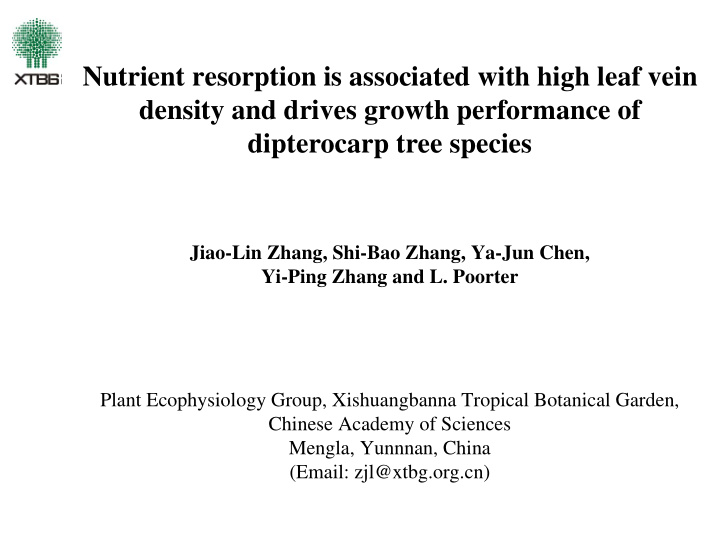



Nutrient resorption is associated with high leaf vein density and drives growth performance of dipterocarp tree species Jiao-Lin Zhang, Shi-Bao Zhang, Ya-Jun Chen, Yi-Ping Zhang and L. Poorter Plant Ecophysiology Group, Xishuangbanna Tropical Botanical Garden, Chinese Academy of Sciences Mengla, Yunnnan, China (Email: zjl@xtbg.org.cn)
Outline � Introduction � Materials and Methods � Results � Summary � Acknowledgements
Definition and significance of nutrient resorption Definition: Nutrient resorption is the process by which nutrients are translocated from senescing leaves to storage organs or growing tissues. Significance: � Contribute a substantial percentage of the nitrogen (N) and phosphorus (P) used annually by plants (Ryan & Bormann, 1982) � Makes a species less dependent on its current capacity for nutrient uptake (Aerts, 1996) � Plant fitness and ecosystem nutrient cycling
However , despite its pivotal role in the nutrient economy of plants and ecosystems, we know surprisingly little: � Which plant traits drive nutrient resorption ? � How resorption efficiency is associated with other leaf traits ? � Whether nutrient resorption has an impact on plant performance ?
Three processes concerning nutrient resorption: Hydrolysis of N- (mainly protein ) and P- (nucleic acids + various P esters + lipids ) containing compounds in the leaves (amino acids + inorganic phosphates) Phloem loading Phloem transport Leaf vein density = Vein length per unit area Sack et al. , 2012
Nutrient resorption and leaf economics spectrum Wright & Westoby 2003
It has been postulated that increased nutrient resorption can increase plant growth performance, especially in nutrient-poor environments, there is a surprising paucity of studies that evaluate whether nutrient resorption matters at all for plant growth. To our knowledge there is no comparative study that directly showed whether enhanced nutrient resorption is indeed associated with increased plant growth (May & Killingbeck 1992).
Hypothesis � Nutrient resorption efficiency is positively related to the phloem transport capacity, as indicated by a high leaf vein density ; � Nutrient resorption efficiency is associated with conservative leaf traits (such as high LMA, leaf thickness) that enhance leaf lifespan and nutrient residence time in the plants ; � Nutrient resorption efficiency is positively related to plant growth.
Xishuangbanna Tropical Botanical Garden San Jose 30 350 Temperature ( o C) 300 Rainfall (mm) 25 250 MAT: 23.7 ℃ 200 20 150 Precipitation: 1,560 mm 100 15 50 10 0 1 2 3 4 5 6 7 8 9 10 11 12 Month
1 1 XTBG 2 1 1 2 1 3 5 17 species from 6 genera of Dipterocarpaceae
Traits measured in this study Leaf anatomy and Nutrient resorption morphology N resorption efficiency Vein density P resorption efficiency Leaf thickness N resorption proficiency Palisade mesophyll thickness P resorption proficiency Spongy mesophyll thickness Nutrient stoichiometry Ratio of palisade to spongy mesophyll thickness N concentration in green leaves Leaf mass per unit area P concentration in green leaves Leaf density N/P ratio in green leaves N/P ratio in senesced leaves Growth Height growth rate Diameter growth rate
� Resorption efficiency: Nitrogen resorption efficiency (NRE): Ngr] × 100 (Kobe et al. 2005) NRE (%) = [(Ngr – Nsen) ⁄ where Ngr and Nsen are the concentrations of N measured from mature green leaves and senesced leaves, respectively. Similar calculations were made for P resorption efficiency (PRE) � Resorption proficiency: Nutrient resorption can also be described in terms of proficiency. N- and P resorption proficiency were defined as N and P concentrations in senesced leaves, respectively (cf. Killingbeck, 1996).
Anisoptera costata Dipterocarpus retusus Hopea hainanensis Parashorea chinensis Shorea assamica Vatica xishuangbannaensis Leaf venation
NRE PRE 80 70 60 53% 60 50 43% PRE (%) NRE (%) 40 40 30 20 20 10 0 0 SR PC Hha DA DT1 VM HM HH VG SS SA DT2 DR VX HC DI AC Hha VM HM HH VG PC SA VX HC DT2 SR DR DA SS DT1 AC DI 60 60 Amazonian China Amazonian China 50 50 40 40 % 30 % 30 48% 53% 47% 53.5% 20 20 10 10 0 0 Variation in NRE and PRE across species
Arrangement of 17 traits along the first two principal component axes (PCA) after Varimax rotation, with construction based on species trait values for 17 dipterocarp species
Relationships of N and P resorption efficiencies with leaf vein density (a, d), leaf mass per unit area (b, e), leaf thickness (c, f) across 17 dipterocarp species
Relationships of N and P concentrations in senesced leaves with leaf vein density (a, d), leaf mass per area (b, e), and leaf thickness (c, f) across 17 dipterocarp species
Relationships of height- (a, b) and diameter (c, d) growth rates with N and P resorption efficiencies across 17 dipterocarp species
Summary Hypothesis H1 Positive association of nutrient resorption Only NRE efficiency with the phloem transport capacity H2 Association of nutrient resorption efficiency Only NRE with conservative leaf traits (such as high LMA, leaf thickness) H3 Positive association of nutrient resorption Only NRE efficiency with plant growth
Acknow ledgements � National Natural Science Foundation of China � Xishuangbanna Tropical Botanical Garden, Chinese Academy of Sciences � Coauthors: Dr. Shi-Bao Zhang, Dr. Ya-Jun Chen, Dr. Yi-Ping Zhang and Dr. L. Poorter
Recommend
More recommend